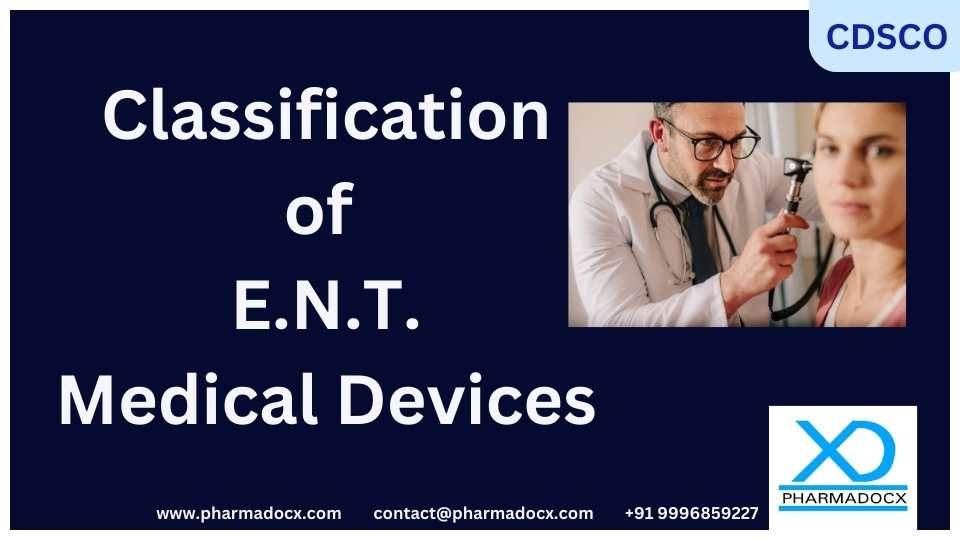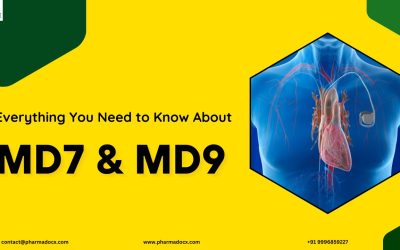The Central Drugs Standard Control Organisation (CDSCO) is the regulatory authority for the medical device industry in India. On 13 September 2021, CDSCO specified 67 ENT medical devices. This list includes devices such as Nasal septum straightening forceps, ENT chairs, Ear wicks, Ear canal lights, and Audiometers, all of which fall under the purview of the Medical Device Rules 2017. Now, let’s look at how these devices are grouped.
Table of contents
CDSCO Classification and Regulation of Medical Devices
Medical devices are put into four classes: A, B, C, and D. These groups are based on how the device is used, the risk it might have, and other rules from the Medical Device Rules 2017. If someone wants to get a license to manufacture medical devices, or a license to import medical devices, they need to follow guidelines from the Ministry of Health & Family Welfare. These guidelines can change because of new technology or other updates in medical devices.
A medical device can be many things. It can be a tool, machine, implant, or even software. The main thing is that it’s used for medical purposes.
Types of Medical Devices
In India, medical devices are of two main types: Notified and Non-Notified. In the past, there were no strict rules for selling medical devices. Manufacturers could sell them without following any specific rules. But later, CDSCO made the Indian Medical Device Regulations (IMDR). With these rules, selling medical devices in India became more controlled. Now, only the notified medical devices need to follow CDSCO’s rules.
- Notified Medical Devices: These devices require approval and oversight from CDSCO before they can be sold or used in India.
- Non-Notified Medical Devices: These devices do not need CDSCO’s approval and can be sold without specific regulatory checks.
After 30 September 2022, all Class A & B Medical Devices become notified medical devices & after 30 September 2023, all Class C & D Medical devices will become notified medical devices. (Only applicable for devices that had been earlier classified as non-notified)
Notified Medical Devices Categories by CDSCO
There are 23 categories of Medical Devices notified by CDSCO. These are –
| S.No. | Medical Device Category |
|---|---|
| 1 | Anesthesiology |
| 2 | Cardiovascular |
| 3 | Dental |
| 4 | Dermatological and Plastic surgery |
| 5 | ENT |
| 6 | Gastroenterology |
| 7 | General Hospital/ Orthopaedic instruments |
| 8 | Radiology |
| 9 | Nephrology and Renal Care |
| 10 | Neurological |
| 11 | Obstetrical and Gynecological |
| 12 | Oncology |
| 13 | Ophthalmology |
| 14 | Ophthalmology |
| 15 | Pain Management |
| 16 | Personal Protective Equipment |
| 17 | Physical Support |
| 18 | Radiotherapy |
| 19 | Rehabilitation |
| 20 | Respiratory |
| 21 | Software |
| 22 | Urology |
| 23 | Non-sterile, Non-Powdered, Hand-Held, or Hand manipulated surgical instruments for general use in various surgical procedures |
Classification of ENT Medical Devices by CDSCO
CDSCO has classified devices in the ENT category based on their intended use and risk class. There are a total of 67 ENT medical devices classified by CDSCO. These are –
| S.No. | Device Name | Intended Use | Risk Class |
|---|---|---|---|
| 1 | Adenotome | Surgical instrument intended to dissect the adenoids. | A |
| 2 | Adenotome blade | Intended to mount on adenotome and perform dissection of adenoids. | B |
| 3 | Audiometer testing system | An assembly of electronic reference devices intended to calibrate an audiometer. | A |
| 4 | Audiometer | Intended for evaluation of hearing by generating tones throughout the audible range | B |
| 5 | Evoked response auditory stimulator | An evoked response auditory stimulator is a device that produces a sound stimulus for use in evoked response measurements or electroencephalogram activation. | B |
| 6 | Behind-the-ear air- conduction hearing aid | Intended to compensate for impaired hearing by transmitting amplified sound waves to the eardrum through air. | B |
| 7 | Behind-the-ear air- conduction tinnitus masker | Intended to provide noise of sufficient intensity and bandwidth to mask tinnitus. | B |
| 8 | Behind-the-ear bone- conduction tinnitus masker | Intended to provide ultrasonic broadband noise and/or sweep-frequency stimuli noise of sufficient intensity and bandwidth to mask tinnitus. | C |
| 9 | Cochlear implant assessment system | Intended to perform an integrity test on the implantable portion of a cochlear implant (CI) system in-situ. | C |
| 10 | Ear bowl | Constructed to fit the curvature of the head so that it will sit closely under the ear lobe and enable treatments of ear. | A |
| 11 | Ear canal impression tray | Intended to hold and confine the impression material in opposition to the surfaces to be recorded, and to control the impression material while it sets to form the impression of the ear canal. | A |
| 12 | Ear canal light | Intended to illuminate the ear canal. | A |
| 13 | Ear excavator | Designed for cutting, scraping, scooping and removing tissue during a surgical procedure in or around the ear. | A |
| 14 | Ear prosthesis | Intended to reconstruct the external ear by replacing damaged or missing tissue. | C |
| 15 | Ear wick | Intended to minimize bleeding during ear surgery. | A |
| 16 | Electroglottograph | Intended for recording the changes in electrical potential or impedance, resulting from movement of the vocal cords during respiration and phonation. | B |
| 17 | Endaural curette | Designed for scraping within the ear canal (e.g., removing wax), and for procedures during middle ear surgery (e.g., removal of the superior bony rim). | A |
| 18 | ENT chair, electric | Designed to support a patient in a seated position, electrically control position in a way to facilitate ear, nose, throat examination, treatment, and/or minor surgery. | A |
| 19 | ENT chair, mechanical | Designed to support a patient in a seated position, mechanically control position in a way to facilitate ear, nose, throat examination, treatment, and/or minor surgery. | A |
| 20 | ENT shaver system | Intended to resect/debride soft and osseous (bone) tissue in the nasal cavity or ear region during ear/nose/throat (ENT) or plastic surgery procedures; including functional endoscopic sinus surgery (FESS). | B |
| 21 | ENT surgical microscope | Intended to magnify minute structures (e.g., nerves, vessels) in the performance of ear, nose, and/or throat (ENT) surgery requiring high magnification and adjustable focusing. | A |
| 22 | ENT transilluminator | Intended to illuminate sinus tissue during an ear/nose/throat (ENT) procedure to render the tissue translucent for examination | A |
| 23 | Evoked-potential audiometer | Electroacoustic instrument designed to evaluate the activity of the auditory pathway of the brain in response to an acoustic signal [auditory brainstem response (ABR)] in patients. | B |
| 24 | Flexible fibreoptic nasopharyngo laryngoscope | Flexible endoscope intended for the visual examination and treatment of the nasal passages, including the sinus openings, the pharyngeal end of the auditory tube, the larynx, and the vocal cords. | B |
| 25 | Flexible fibreoptic nasopharyngoscope | Flexible endoscope intended for the visual examination and treatment of nasopharynx (the upper part of the throat behind the nose). | B |
| 26 | Flexible fibreoptic rhinoscope | Flexible endoscope intended for the visual examination and treatment of nasal cavity. | B |
| 27 | Flexible fibreoptic sinoscope | Flexible endoscope intended for the visual examination and treatment of the paranasal sinuses during an ear/nose/throat (ENT) intervention. | B |
| 28 | Flexible video antroscope | Flexible endoscope intended for the visual examination and treatment of a cavity, particularly the pathological changes in the area of the maxillary sinus. | B |
| 29 | Impedance audiometer | Intended to evaluate the functional condition of the middle ear by changing the air pressure in the external auditory canal to measure and graph the mobility characteristics of the tympanic membrane. | B |
| 30 | Nasal septum straightening forceps | Surgical instrument specifically designed to straighten the nasal septum through grasping and manipulation of the bone/cartilage of the septum during nasal reconstructive procedures. | A |
| 31 | Otoscope, endoscopic | Intended to be used in otology mainly for observation, diagnosis, and treatment of the outer and/or middle ear. | A |
| 32 | Tonsil knife | Intended for the removal of the tonsils during a surgical intervention. | A |
| 33 | Tracheal bistoury | Designed for opening abscesses or slitting up sinuses and/or fistulas in the trachea. | A |
| 34 | Middle ear mold | A middle ear mold is a preformed device that is intended to be implanted to reconstruct the middle ear cavity during repair of the tympanic membrane. | C |
| 35 | Fully-implantable middle ear implant system | An implanted assembly of sterile devices intended to compensate for impaired hearing by transmitting vibrations to the middle ear. It is powered by a battery that is recharged inductively, via an external device. | C |
| 36 | Larynx prosthesis | A device used for replacement and restoration of the laryngeal function, or for maintenance of patency of the larynx. | C |
| 37 | Epistaxis balloon | Device intended to control internal nasal bleeding by exerting pressure against the sphenopalatine artery. | B |
| 38 | Eustachian tube balloon dilation system | The system is intended for use in dilating the cartilaginous portion of the Eustachian tube for treating persistent Eustachian tube dysfunction. | B |
| 39 | Argon laser for otology, rhinology, and laryngology | Device is used for the purpose of coagulating and vaporizing soft and fibrous tissues, including osseous tissue while performing ENT surgical procedure. | C |
| 40 | Ear, nose, and throat microsurgical carbon dioxide laser | Device intended for the surgical excision of tissue from the ear, nose, and throat area while performing microsurgical procedures to excise lesions and tumors of the vocal cords and adjacent areas. | C |
| 41 | Esophagoscope (flexible or rigid) | Device intended to examine or treat esophageal malfunction symptoms, esophageal or mediastinal disease, or to remove foreign bodies from the esophagus. | B |
| 42 | Mediastinoscope and accessories | Device intended to examine or treat tissue in the area separating the lungs for diagnosis of tumors and lesions and to determine whether excision of certain organs or tissues is indicated. | B |
| 43 | Laryngostroboscope | A laryngostroboscope is a device that is intended to allow observation of glottic action during phonation. | B |
| 44 | Bone particle collector | A bone particle collector is a filtering device intended to be inserted into a suction tube during the early stages of otologic surgery to collect bone particles for future use. | A |
| 45 | Suction antichoke device | A suction antichoke device is a device intended to be used in an emergency situation to remove, by the application of suction, foreign objects that obstruct a patient’s airway to prevent asphyxiation to the patient. | C |
| 46 | Tongs antichoke device | A tongs antichoke device is a device that is intended to be used in an emergency situation to grasp and remove foreign objects that obstruct a patient’s airway to prevent asphyxiation of the patient. | C |
| 47 | Powered nasal irrigator | A powered nasal irrigator is an AC-powered device intended to wash the nasal cavity by means of a pressure-controlled pulsating stream of water. | B |
| 48 | External nasal splint | An external nasal splint is a rigid or partially rigid device intended for use externally for immobilization of parts of the nose. | A |
| 49 | Antistammering device | An antistammering device intended to minimize a user’s involuntary hesitative or repetitive speech. It also prevent the user from hearing the sounds of his or her own voice | B |
| 50 | External upper esophageal sphincter compression device | An external upper esophageal sphincter compression device is intended to apply external pressure on the cricoid cartilage for the purpose of reducing the symptoms of laryngopharyngeal reflux disease. | C |
| 51 | Wireless air-conduction hearing aid | A wireless air-conduction hearing aid is intended to compensate for impaired hearing that incorporates wireless technology in its programming or use. | B |
| 52 | Hearing aid calibrator and analysis system | A hearing aid calibrator and analysis system is an electronic reference device intended to calibrate and assess the electroacoustic frequency and sound intensity characteristics emanating from a hearing aid, master hearing aid, group hearing aid or group auditory trainer. | B |
| 53 | Tympanic membrane contact hearing aid | A tympanic membrane contact hearing aid is a prescription device that compensates for impaired hearing by vibrating the tympanic membrane through a transducer that is in direct contact with the tympanic membrane. | B |
| 54 | Master hearing aid | A master hearing aid is an electronic device intended to simulate a hearing aid during audiometric testing. | B |
| 55 | Active implantable bone conduction hearing system | The active implantable bone conduction hearing system is intended to compensate for conductive or mixed hearing losses by conveying amplified acoustic signals to the cochlea via mechanical vibrations on the skull bone. | C |
| 56 | Battery-powered artificial larynx | A battery-powered artificial larynx is an externally applied device intended for use in the absence of the larynx to produce sound. | B |
| 57 | Nasal dilator | A nasal dilator is a device intended to provide temporary relief from transient causes of breathing difficulties resulting from structural abnormalities and/or transient causes of nasal congestion associated with reduced nasal airflow. | A |
| 58 | Transcutaneous air conduction hearing aid system | A transcutaneous air conduction hearing aid system is a wearable sound-amplifying device intended to compensate for impaired hearing without occluding the ear canal. | C |
| 59 | Acoustic chamber for audiometric testing | An acoustic chamber for audiometric testing is a room that is intended for use in conducting diagnostic hearing evaluations and that eliminates sound reflections and provides isolation from outside sounds. | A |
| 60 | Gustometer | A gustometer is a battery-powered device that consists of two electrodes that are intended to provide galvanic stimulus resulting in taste sensation. | B |
| 61 | ENT cupped forceps | A forcep with a spoon-(dish) like configuration at the distal end, and is used to treat the ear, nose, and throat (ENT), and remove tissue from the body. | A |
| 62 | Tongue depressor | A surgical instrument used to move the tongue to facilitate examination of surrounding organs and tissue. | A |
| 63 | Tonsillectome | A manually operated surgical device used to dissect the tonsils. | A |
| 64 | ENT Nasal snare | A hand-held manual surgical instrument intended to be inserted into the naris for the removal of tissue, typically polyps, tumours, and other abnormal tissue from the nasal cavity during ear/nose/throat (ENT) surgery | A |
| 65 | Otoscope, direct | A portable, battery-powered, hand-held device (non-endoscopic) primarily designed for examination of the outer ear canal and tympanic membrane (eardrum) by direct viewing through the ear opening. | A |
| 66 | Soft-tissue surgical forceps, alligator | A long, thin, hand-held manual surgical instrument designed to facilitate grasping and manipulation of soft-tissues/anatomical structures [typically during ear/nose/throat (ENT) surgery]. | A |
| 67 | Ear, nose, and throat electric or pneumatic surgical drill | An ear, nose, and throat electric or pneumatic surgical drill is a rotating drilling device, including the handpiece, that is intended to drive various accessories, such as an ear, nose, and throat bur for the controlled incision or removal of bone in the ear, nose, and throat area. | B |
Pharmadocx Consultants provides services for the grant of CDSCO manufacturing and import licenses for ENT Medical Devices. Contact us today to get started in the world of medical devices!
Call/Whatsapp on +91 9996859227 or write to us at [email protected] for the first free consultation.
Read More –





0 Comments